Abstract
In this work, we propose exchange-coupled-composite-bit-patterned media (ECC-BPM) with microwave-assisted magnetic recording (MAMR) to improve the writability of the magnetic media at a 4 Tb/in2 recording density. The suitable values of the applied microwave field’s frequency and the exchange coupling between magnetic dots, Adot, of the proposed media were evaluated. It was found that the magnitude of the switching field, Hsw, of the bilayer ECC-BPM is significantly lower than that of a conventional BPM. Additionally, using the MAMR enables further reduction of Hsw of the ECC-BPM. The suitable frequency of the applied microwave field for the proposed media is 5 GHz. The dependence of Adot on the Hsw was additionally examined, showing that the Adot of 0.14 pJ/m is the most suitable value for the proposed bilayer ECC-BPM. The physical explanation of the Hsw of the media under a variation of MAMR and Adot was given. Hysteresis loops and the magnetic domain of the media were characterized to provide further details on the results. The lowest Hsw found in our proposed media is 12.2 kOe, achieved by the bilayer ECC-BPM with an Adot of 0.14 pJ/m using a 5 GHz MAMR.
1. Introduction
Recently, the capacity of hard disk drives has been heading towards a stalemate since the thermal stability of the conventional media has reached its limitation [1,2,3,4,5,6]. In order to increase recording densities, several techniques have been proposed to overcome the stability limitation, such as exchange-coupled-composite (ECC) media, heat-assisted magnetic recording (HAMR) bit-patterned media (BPM), and microwave-assisted magnetic recording (MAMR) [1,7,8,9,10,11,12,13,14]. The ECC media have been introduced to improve the magnetic properties of the media; the major goal is to reduce the magnitude of the switching field, Hsw [7,12,13]. The ECC media consist of magnetically isolated layers, which are the soft and the hard magnetic layers. The interface exchange coupling between two layers can provide a lower Hsw than the conventional one. It therefore enables the use of smaller media grain sizes with higher magnetic anisotropy, Ku, at high areal densities [7]. BPM technology has been extensively proposed to solve the magnetic transition noise and the interaction between magnetic bits of the conventional media since these factors could be the crucial issues at ultrahigh areal densities [1]. The principle of BPM is the magnetic separation of each magnetic bit, which eliminates the magnetic transition noise and yields a very low interaction between bits [1]. In previous research, the combination of ECC-BPM was reported, demonstrating that this combined technique can increasingly reduce the Hsw of the media beyond that using each technique individually [12]. Microwave-assisted magnetic recording (MAMR) is one promising technology for achieving higher areal densities [14,15,16,17,18]. The goal of this technique is to reduce the Hsw of the media by using an AC-magnetic field, Hac, operated at a microwave range. During the writing process of MAMR, the Hac is applied to the media simultaneously with the writing field, Hdc. This strategy can increasingly reduce the energy barrier of the media by the ferromagnetic resonance (FMR) phenomenon. As a result, switching the magnetization of the media becomes easier. A significant reduction in the Hsw of the media under the use of MAMR can be seen in several recent publications [14,15,16,17,18].
As it is generally known that the maximum write head field is limited, it is challenging to continuously reduce the Hsw to enable the use of higher Ku materials as a media at higher recording densities [19]. Therefore, we proposed a novel technique to improve the writability of the media by the combination of three technologies, including the ECC media, BPM, and MAMR. The proposed media was targeted for use at an areal density of 4 Tb/in2. The hybrid magnetic recording media based on the FePt alloy with the face-centered tetragonal L10 structure, L10-FePt, was focused. The object-oriented micromagnetic framework (OOMMF) software [20] was used in the simulations implementing the Landau–Lifshitz–Gilbert (LLG) equation.
2. Modeling and Analytical Methodology
The model structures of the L10-FePt-based single-layer BPM and the L10-FePt/Fe bilayer ECC-BPM for an areal density of 4 Tb/in2 are shown in Figure 1a,b, respectively. The media configuration has been determined on the basis of BPM and ECC-BPM requirements. To achieve an areal density of 4 Tb/in2, the cube dot size of single-layer BPM of 10 × 10 × 10 nm3 and spacing between dots of 2.5 nm were assumed [12]. The bilayer ECC-BPM was introduced by magnetically adding a soft Fe layer with a 10 nm thickness under the FePt BPM. The Fe added layer was assumed to have the same dot pattern as the single-layer BPM. The magnetization of each layer was initially aligned along the +z direction for both media. The magnetic properties of the proposed media are detailed as follows: the L10-FePt hard layer had a saturation magnetization, Ms, of 1.175 MA/m, and a Ku of 2.8 MJ/m3. The Fe soft layer had Ms of 1.71 MA/m and Ku of 100 J/m3. For the bilayer media, the exchange coupling between soft and hard layers, Aex, was assumed to be 25 pJ/m, whereas the exchange coupling between magnetic dots, Adot, varied from 0.1 to 0.3 pJ/m. This variation of Adot was based on the possible values of the filled material between the dot spacing, as can be seen in the literature [21,22]. In calculations, the time-varying magnetization was described by the LLG equation, given as Equation (1) [23]:
where is the magnetization, γ is the gyromagnetic ratio, and is the effective magnetic field given by Equation (2):
where and are the external static magnetic field, the exchange field between nearest-neighbor cells, the demagnetizing field, the field due to uniaxial anisotropy, the amplitude of microwave field, the microwave frequency, and the unit vector along the x-axis, respectively.
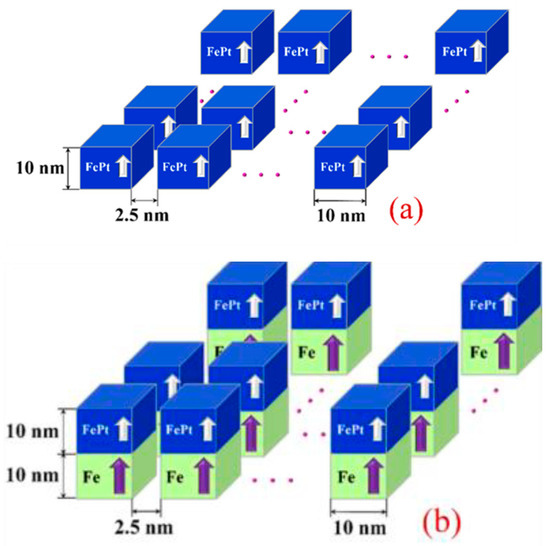
Figure 1.
(a) Single layer BPM and (b) bilayer ECC-BPM.
To investigate the writability of the media, the external DC write field, Hdc, was applied to the media in the z-direction. The write head field region was defined as the region where the magnetization of the media can be written by the write head field. The Hsw of the media was collected in the condition that M = −0.8Ms. For the MAMR included, the Hac was simultaneously applied to Hdc with a magnitude of 100 mT in the x-direction. The Hsw of the proposed ECC-BPM was examined at various frequencies of Hac. Since Adot typically has an influential impact on the Hsw, the dependence of Adot on the Hsw was also taken into account. Then, the hysteresis loops and magnetic domain of a bilayer ECC-BPM were determined and compared with those of a single-layer BPM.
3. Results and Discussions
The Hsw of the proposed bilayer ECC-BPM at different Adot values was investigated at fac between 0 and 25 GHz, as shown in Figure 2. It was discovered that changing Adot or fac could change the Hsw. Without MAMR, the media with an Adot of 0.14 pJ/m have the lowest Hsw, followed by those with an Adot of 0.12, 0.25, and 0.30 pJ/m, respectively. A variation of Adot under the MAMR indicates a similar trend of Hsw for all fac. When the MAMR was performed, it revealed that increasing the fac from 0 to 2 GHz slightly changes the Hsw of the media. Then, the Hsw was dramatically reduced to the range of fac about 5–7.5 GHz. Above fac of 10 GHz, the Hsw of all media tended to have a higher Hsw than that without MAMR and was insignificantly changed with varying fac. From the results, the media with Adot = 0.25, 0.30 pJ/m indicate their lowest Hsw at a fac of 5 GHz, whereas the lowest Hsw of media with Adot = 0.12, 0.14 pJ/m occurs at a fac of 7.5 GHz. The lowest Hsw found in this evaluation is 11.9 kOe, achieved by the media with an Adot of 0.14 pJ/m with MAMR at a fac of 7.5 GHz. However, since the resonance frequency of our proposed system is 5 GHz, we therefore examined more details of Adot’s influence on the Hsw at this frequency.
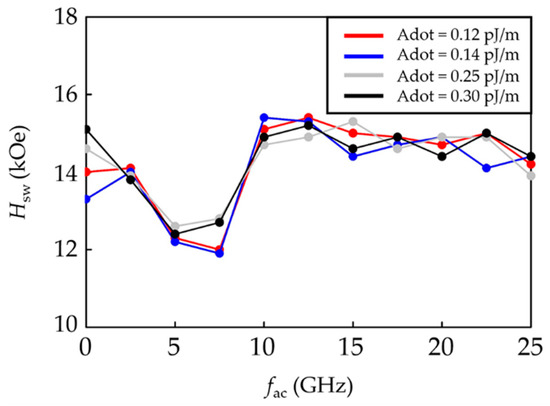
Figure 2.
Hsw of the bilayer ECC-BPM versus fac at various Adot.
Figure 3 displays the Hsw of the bilayer ECC-BPM as a function of Adot, in the cases without and with the MAMR at fac = 5 GHz. Overall, it shows that using MAMR can significantly reduce the Hsw of the media for all Adot values. Additionally, the media with MAMR indicate less variation of Hsw with a varying Adot than that without MAMR. The lowest Hsw of ECC-BPM without and with MAMR is 13.1 kOe at Adot = 0.16 pJ/m and 12.2 kOe at Adot = 0.14 pJ/m, respectively. The Hsw alternation with varying Adot at other fac is supposed to provide a higher Hsw than that at fac = 5 GHz due to its larger conventional value and therefore is not considered in this work.
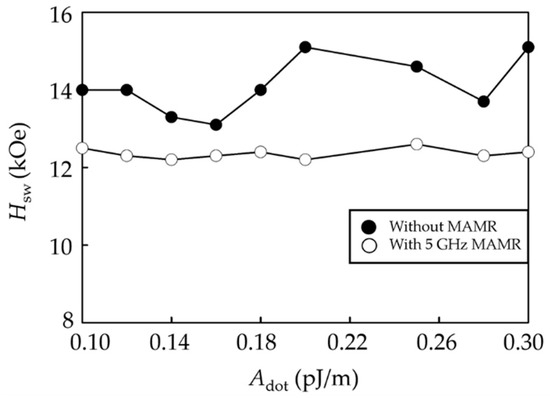
Figure 3.
Hsw of the bilayer ECC-BPM with and without HAMR as a function of Adot.
In a case without MAMR, the media with higher Adot tend to have higher Hsw. A magnitude of Adot normally represents an exchange interaction between magnetic dots of the media. This interaction indicates an interacting force between adjacent magnetizations. At higher Adot, each magnetic dot is strongly related to each other due to a massive exchange interaction between them. When the write head field is applied to the media, the magnetization of the media with higher Adot is more homogeneously processed, then it is more difficult to be switched.
The physical reason why a variation of fac can alter the Hsw of media with MAMR can be explained by the FMR phenomenon, as follows: when the magnetization precession of a ferromagnetic material is under the effect of an external magnetic field, the FMR frequency, f0, can be obtained by f0 = γ(H − 4πMs,eff) [24] where H is the magnitude of media switching field with an absence of MAMR and Ms,eff is the effective saturation magnetization of the bilayer ECC-BPM. The FMR itself can exert additional energy on the magnetization through the resonance phenomenon, which causes the additional magnetization precession. The magnitude of this added energy depends on the frequency of the external microwave field. The maximum added energy occurs when the fac is synchronized with the FMR frequency of the system, which typically provides a significant reduction in Hsw. In addition, the reason why the media with MAMR have a lower Hsw than the conventional media is that the magnetization precession of the media subjected to the microwave field receives the additional energy exerted by the microwave field. The magnetization of the hard layer, therefore, requires lower Hsw for switching than in a case without MAMR. In particular, this additional torque energy becomes massive when the frequency of MAMR corresponds with the precession frequency of its FMR.
A comparison of the hysteresis loops of the single-layer BPM and the bilayer ECC-BPM for cases without and with 5 GHz MAMR is indicated in Figure 4. The Adot of 0.14 pJ/m was selected for this characterization for both media since this value previously demonstrates the lowest Hsw under MAMR. In this figure, the Hsw is determined at the point that M = −0.8Ms. From the results, the single-layer BPM has the Hsw of 27 kOe and 26 kOe for cases without and with MAMR, respectively. By adding the Fe soft layer to the single-layer BPM, the Hsw of the bilayer ECC-BPM for the cases without and with MAMR was reduced to 13.3 kOe and 12.2 kOe, respectively, which are significantly lower than that of the single-layer BPM. To provide more information about the magnetization orientation of the media, the magnetic domain of four media was characterized at the points where Hdc = −18 kOe since this particular Hdc can indicate the difference between them. Figure 5a,d show the magnetic domain from the cross-sectional side view of media at the points shown by circles (a–d) in Figure 4, respectively. It is seen that the magnetization of the single-layer BPM with MAMR contains more reversed magnetization than that without MAMR, demonstrating the effects of MAMR assisting the magnetization switching. Additionally, the magnetization of the bilayer ECC-BPMs is greatly reversed when compared to the single-layer BPM. The use of the MAMR in the bilayer ECC-BPM indicates a slightly better reversal of magnetization.
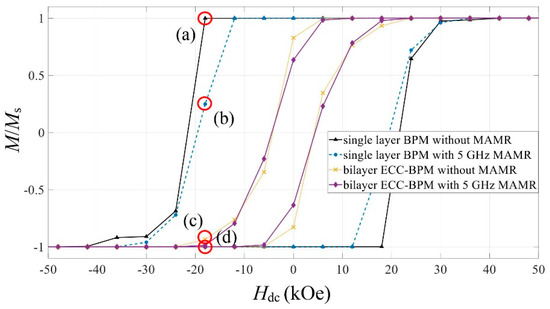
Figure 4.
The hysteresis loops of the single-layer BPM and the bilayer ECC-BPM with and without MAMR (Adot = 0.14 pJ/m for both media).
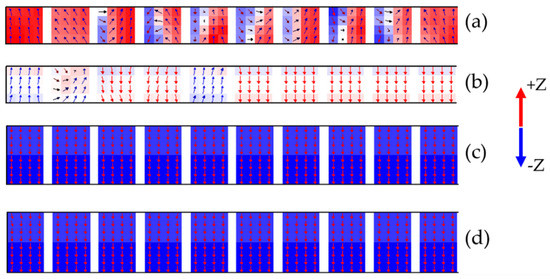
Figure 5.
Magnetic domain from cross-sectional side view of (a) Single-layer BPM; (b) Single-layer BPM with MAMR; (c) Bilayer ECC-BPM; (d) Bilayer ECC-BPM with MAMR at Hdc = −18 kOe.
From overall evaluations, the lowest Hsw found in this work is 12.2 kOe, achieved by the proposed bilayer ECC-BPM with an Adot of 0.14 pJ/m using a 5 GHz MAMR, which is below the maximum write head field existed in the literature. Therefore, this proposed bilayer ECC-BPM could be another choice as the magnetic media for an areal density of 4 Tb/in2 of data storage technology. It should be noted that the suitable value of Adot and fac for other media and areal densities recording systems needs to be carefully optimized. The theoretical findings can be the guidelines for its experimental verification as well as further development of magnetic media in the future.
4. Conclusions
In this work, the L10-FePt single-layer BPM and L10-FePt/Fe bilayer ECC-BPM with MAMR technology were proposed to improve the writability of the magnetic media at a 4 Tb/in2 recording density. It was found that the Hsw bilayer ECC-BPM was significantly lower than that of the single-layer BPM. The Hsw of those media could be increasingly reduced by using MAMR. The suitable frequency of the applied microwave field was 5 GHz, which was consistent with the FMR of the system. The suitable value of Adot for the proposed bilayer ECC-BPM under MAMR was 0.14 pJ/m. The physical explanation of the Hsw of the medium regarding a variation of MAMR and Adot was given. The hysteresis loops and magnetic domain of the medium have been considered to provide further details on the simulation results. The lowest Hsw found in this proposed medium is 12.2 kOe, achieved by the bilayer ECC-BPM with an Adot of 0.14 pJ/m using a 5 GHz MAMR. Findings can be used for the future development of ultra-high areal densities magnetic recording technology.
Author Contributions
Conceptualization, P.K., N.W., and A.K. (Arkom Kaewrawang); methodology, P.K., N.W., and A.K, (Arkom Kaewrawang); software, N.W. C.J., and A.K. (Arkom Kaewrawang); validation, P.K., N.W., C.J., and A.K. (Arkom Kaewrawang); formal analysis, P.K., N.W., and A.K. (Arkom Kaewrawang); investigation, N.W. and A.K. (Arkom Kaewrawang); data curation, P.K., N.W., and A.K. (Arkom Kaewrawang); writing—original draft preparation, P.K. and N.W.; writing—review and editing, P.K., N.W., C.J., and A.K. (Arkom Kaewrawang); visualization, N.W., C.J., A.K. (Arkom Kaewrawang), A.S., and A.K. (Arkom Kaewrawang); supervision, A.K. (Arkom Kaewrawang) and A.S.; project administration, A.K. (Arkom Kaewrawang); funding acquisition, P.K and A.K. (Arkom Kaewrawang) All authors have read and agreed to the published version of the manuscript.
Funding
This work was financially supported by the Thailand Research Fund (TRF) and Khon Kaen University (Grant No. TRG5780125), and the Office of the Permanent Secretary, Ministry of Higher Education, Science, Research and Innovation (Grant No. RGNS 63-058).
Acknowledgments
The authors would like to thank Warunee Tipcharoen and Edanz Group Global Ltd.
Conflicts of Interest
The authors declare no conflict of interest.
References
- Ross, C. Patterned Magnetic Recording Media. Annu. Rev. Mater. Res. 2001, 31, 203–235. [Google Scholar] [CrossRef]
- Khunkitti, P.; Siritaratiwat, A.; Kaewrawang, A.; Mewes, T.; Mewes, C.; Kruesubthaworn, A. Electromagnetic interference-induced instability in CPP-GMR read heads. J. Magn. Magn. Mater. 2016, 412, 42–48. [Google Scholar] [CrossRef]
- Nagasaka, K. CPP-GMR technology for magnetic read heads of future high-density recording systems. J. Magn. Magn. Mater. 2009, 321, 508–511. [Google Scholar] [CrossRef]
- Khunkitti, P.; Pituso, K.; Chaiduangsri, N.; Siritaratiwat, A. Optimal Sizing of CPP-GMR Read Sensors for Magnetic Recording Densities of 1–4 Tb/in2. IEEE Access 2021, 9, 130758–130766. [Google Scholar] [CrossRef]
- Khunkitti, P.; Kaewrawang, A.; Siritaratiwat, A.; Mewes, T.; Mewes, C.K.A.; Kruesubthaworn, A. A novel technique to detect effects of electromagnetic interference by electrostatic discharge simulator to test parameters of tunneling magnetoresistive read heads. J. Appl. Phys. 2015, 117, 17A908. [Google Scholar] [CrossRef]
- Khunkitti, P.; Siritaratiwat, A.; Pituso, K. Free Layer Thickness Dependence of the Stability in Co2(Mn0.6Fe0.4)Ge Heusler Based CPP-GMR Read Sensor for Areal Density of 1 Tb/in2. Micromachines 2021, 12, 1010. [Google Scholar] [CrossRef] [PubMed]
- Wang, J.-P.; Shen, W.; Bai, J. Exchange coupled composite media for perpendicular magnetic recording. IEEE Trans. Magn. 2005, 41, 3181–3186. [Google Scholar] [CrossRef]
- Wang, Y.; Erden, M.F.; Victora, R.H. Novel system design for readback at 10 terabits per square inch user areal density. IEEE Magn. Lett. 2012, 3, 4500304. [Google Scholar]
- Zhao, B.; Xue, H.; Zhu, Z.; Ren, Y.; Jin, Q.Y.; Zhang, Z. Interlayer modulation on the dynamic magnetic properties of L10-FePt/NM/[CoNi]5 composite film structures. Appl. Phys. Lett. 2019, 115, 062401. [Google Scholar] [CrossRef]
- Pituso, K.; Khunkitti, P.; Tongsomporn, D.; Kruesubthaworn, A.; Chooruang, K.; Siritaratiwat, A.; Kaewrawang, A. Simulation of magnetic footprints for heat assisted magnetic recording. Eur. Phys. J. Appl. Phys. 2017, 78, 20301. [Google Scholar] [CrossRef]
- Pituso, K.; Kaewrawang, A.; Buatong, P.; Siritaratiwat, A.; Kruesubthaworn, A. The temperature and electromagnetic field distributions of heat-assisted magnetic recording for bit-patterned media at ultrahigh areal density. J. Appl. Phys. 2015, 117, 17C501. [Google Scholar] [CrossRef]
- Tipcharoen, W.; Kaewrawang, A.; Siritaratiwat, A. Design and Micromagnetic Simulation of Fe/L10-FePt/Fe Trilayer for Exchange Coupled Composite Bit Patterned Media at Ultrahigh Areal Density. Adv. Mater. Sci. Eng. 2015, 2015, 504628. [Google Scholar] [CrossRef] [Green Version]
- Krone, P.; Makarov, D.; Schrefl, T.; Albrecht, M. Exchange coupled composite bit patterned media. Appl. Phys. Lett. 2010, 97, 82501. [Google Scholar] [CrossRef]
- Boone, C.; Katine, J.A.; Marinero, E.E.; Pisana, S.; Terris, B.D. Microwave-Assisted Magnetic Reversal in Perpendicular Media. IEEE Magn. Lett. 2012, 3, 3500104. [Google Scholar] [CrossRef]
- Fal, T.J.; Camley, R.E. Microwave assisted switching In bit patterned media: Accessing multiple states. Appl. Phys. Lett. 2010, 97, 122506. [Google Scholar] [CrossRef]
- Bai, X.; Zhu, J.-G. Effective Field Analysis of Segmented Media for Microwave-Assisted Magnetic Recording. IEEE Magn. Lett. 2017, 8, 1–4. [Google Scholar] [CrossRef]
- Greaves, S.J.; Chan, K.S.; Kanai, Y. Areal Density Capability of Dual-Structure Media for Microwave-Assisted Magnetic Re-cording. IEEE Trans. Magn. 2019, 55, 6701509. [Google Scholar] [CrossRef]
- Tanaka, T.; Kurihara, K.; Ya, X.; Kanai, Y.; Bai, X.; Matsuyama, K. MAMR writability and signal-recording characteristics on granular exchange-coupled composite media. J. Magn. Magn. Mater. 2021, 529, 167884. [Google Scholar] [CrossRef]
- Shiroishi, Y.; Fukuda, K.; Tagawa, I.; Iwasaki, H.; Takenoiri, S.; Tanaka, H.; Mutoh, H.; Yoshikawa, N. Future Options for HDD Storage. IEEE Trans. Magn. 2009, 45, 3816–3822. [Google Scholar] [CrossRef]
- Donahue, M.J.; Porter, D.G. OOMMF User’s Guide, Release 1.2a3. Available online: https://math.nist.gov/oommf/ftp-archive/doc/userguide12a3_20021030.pdf (accessed on 15 October 2021).
- Barmak, K.; Coffey, K.R.; Thiele, J.-U.; Kim, J.; Lewis, L.H.; Toney, M.F.; Kellock, A.J. Stoichiometry-anisotropy connections in epitaxial L10 FePt(001) films. J. Appl. Phys. 2004, 95, 7501–7503. [Google Scholar] [CrossRef]
- Wang, F.; Xu, X.-H.; Liang, Y.; Zhang, J.; Zhang, J. Perpendicular L10-FePt/Fe and L10-FePt/Ru/Fe graded media obtained by post-annealing. Mater. Chem. Phys. 2011, 126, 843–846. [Google Scholar] [CrossRef]
- Laval, M.; Bonnefois, J.J.; Bobo, J.F.; Issac, F.; Boust, F. Microwave-assisted switching of NiFe magnetic microstructures. J. Appl. Phys. 2009, 105, 73912. [Google Scholar] [CrossRef]
- Kittel, C. Introduction to Solid State Physics; John Wiley & Sons: Hoboken, NJ, USA, 2011. [Google Scholar]
Publisher’s Note: MDPI stays neutral with regard to jurisdictional claims in published maps and institutional affiliations. |
© 2021 by the authors. Licensee MDPI, Basel, Switzerland. This article is an open access article distributed under the terms and conditions of the Creative Commons Attribution (CC BY) license (https://creativecommons.org/licenses/by/4.0/).